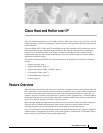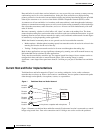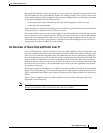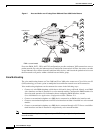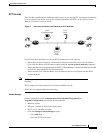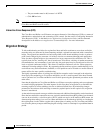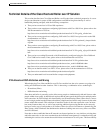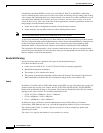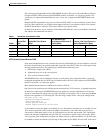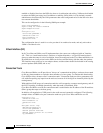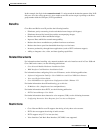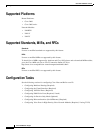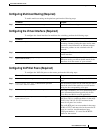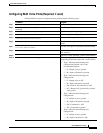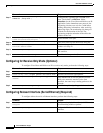
Cisco Hoot and Holler over IP
Feature Overview
3
Cisco IOS Release 12.1(5)T
Hoot and holler networks are typically spread over four to eight sites, although financial retail networks
may have hundreds of sites interconnected. Within a site, bridging (mixing voice signals) is done locally
with a standard analog or digital bridge that may be part of a trading turret system. Between sites, there
are two prevalent methods for providing transport:
• Point-to-point leased lines with customer-provided audio bridging at a central site, and
• Carrier-provided audio bridging.
When customers provide their own bridging services with point-to-point leased lines, branch offices in
a metropolitan area commonly have 25 to 50 lines or more.
The second method, carrier-provided audio bridging, is prevalent within the United States but rare for
overseas transport. In this scenario, the audio bridges are located at the carrier's central office and the
4-wire lines are terminated at the client's site on a local audio-bridge equipped with 4-wire plug-ins,
which then feed to local PA system speakers. Customer-provided hoot bridging services can now be
replaced with Cisco Hoot and Holler over IP solutions.
An Overview of Cisco Hoot and Holler over IP
Cisco's VoIP technology, which was initially focused on traditional PBX toll-bypass applications, can
be used to combine hoot and holler networks with data networks. While some customers may have done
some level of hoot and data integration in the late 1980s with time-division multiplexing (TDM), this
form of integration does not allow for dynamic sharing of bandwidth that is characteristic of VoIP. This
dynamic sharing of bandwidth is even more compelling with hoot and holler than with a toll-bypass
application, because some hoot circuits may be active for an hour or two for morning reports but might
be dead for the rest of the day—the idle bandwidth can be used by the data applications during these
long periods of inactivity.
Beginning with the Cisco IOS Release 12.1(2)XH, Cisco Hoot and Holler over IP can be implemented
using Cisco's VoIP technology. This solution leverages Cisco's IOS expertise in VoIP, quality of service
(QoS), and IP multicasting (IPmc) and is initially available on Cisco 2600 and 3600 series multiservice
routers.
Figure 2 shows a diagram of the Cisco Hoot and Holler over IP solution connecting legacy hoot
equipment over an IP network.
Note The "V" on the Cisco router icons signifies that some of the hoot and holler bridging
function is being done by the router's digital signal processors (DSPs).



